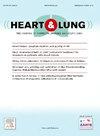Performance of objective cough measurement, diaphragmatic contraction velocity, and spontaneous breathing trial for predicting extubation success in critically ill patients stratified by BMI: A prospective multicentre study
IF 2.6
4区 医学
Q2 CARDIAC & CARDIOVASCULAR SYSTEMS
引用次数: 0
Abstract
Background
The transition from Invasive mechanical ventilation (IMV) to spontaneous breathing, known as the weaning-process (WP), requires careful evaluation. In obese patients, WP may be compromised due to altered respiratory mechanics, increasing the risk of weaning failure.
Objective
to evaluate the predictive capacity of objective cough measurement (OCM), spontaneous breathing trial (SBT), and diaphragmatic contraction velocity (DCV) in predicting WP success in obese patients.
Methods
A prospective, multicenter cohort study was conducted in critically ill patients requiring IMV who were undergoing the extubation process. The predictive ability of SBT, DCV, and OCM for determining SBT and extubation success was evaluated. The analysis was stratified by body mass index (BMI <30 kg/m² vs. ≥30 kg/m²) to assess predictive performance across different weight categories.
Results
A total of 367 patients were included, of whom 70 % (279/367) had a BMI <30 kg/m². OCM and DCV showed an AUC-ROC of 0.49 (95 % CI: 0.39–0.60) and 0.50 (95 % CI: 0.40–0.60) in the BMI <30 kg/m² and ≥30 kg/m² groups for predicting success in the SBT, respectively (p = 0.9510). The SBT showed an AUC-ROC of 0.83 (95 % CI: 0.70–0.98) and 0.87 (95 % CI: 0.82–0.92) in the BMI <30 kg/m² and ≥30 kg/m² groups for predicting successful extubation, respectively (p = 0.252). The SBT and DCV showed an AUC-ROC of 0.86 (95 % CI: 0.80–0.92) and 0.74 (95 % CI: 0.61–0.87) in the BMI <30 kg/m² and ≥30 kg/m² groups for predicting successful extubation, respectively (p = 0.113). The SBT and OCM showed an AUC-ROC of 0.90 (95 % CI: 0.86–0.94) and 0.85 (95 % CI: 0.77–0.93) in the BMI <30 kg/m² and ≥30 kg/m² groups for predicting successful extubation, respectively (p = 0.243).
Conclusion
The SBT demonstrated the highest predictive accuracy for successful extubation across BMI groups, while OCM and DCV had limited predictive value. No significant differences were observed between BMI categories.
客观咳嗽测量、膈肌收缩速度和自主呼吸试验预测BMI分层危重患者拔管成功率的表现:一项前瞻性多中心研究
从有创机械通气(IMV)到自主呼吸的过渡,即脱机过程(WP),需要仔细评估。在肥胖患者中,由于呼吸力学的改变,WP可能受到损害,增加了脱机失败的风险。目的评价客观咳嗽测量(OCM)、自主呼吸试验(SBT)和膈肌收缩速度(DCV)对肥胖患者WP成功的预测能力。方法采用前瞻性、多中心队列研究,对拔管过程中需要IMV的危重患者进行研究。评估SBT、DCV和OCM对SBT和拔管成功的预测能力。根据体重指数(BMI <30 kg/m²vs.≥30 kg/m²)对分析进行分层,以评估不同体重类别的预测效果。结果共纳入367例患者,其中70% (279/367)BMI为30 kg/m²。在BMI≤30 kg/m²和≥30 kg/m²组中,OCM和DCV预测SBT成功的AUC-ROC分别为0.49 (95% CI: 0.39-0.60)和0.50 (95% CI: 0.40-0.60) (p = 0.9510)。BMI≤30 kg/m²和≥30 kg/m²组的SBT预测拔管成功的AUC-ROC分别为0.83 (95% CI: 0.70-0.98)和0.87 (95% CI: 0.82-0.92) (p = 0.252)。BMI≤30 kg/m²和≥30 kg/m²组的SBT和DCV预测拔管成功的AUC-ROC分别为0.86 (95% CI: 0.80-0.92)和0.74 (95% CI: 0.61-0.87) (p = 0.113)。在BMI≤30 kg/m²和≥30 kg/m²组中,SBT和OCM预测拔管成功的AUC-ROC分别为0.90 (95% CI: 0.86-0.94)和0.85 (95% CI: 0.77-0.93) (p = 0.243)。结论SBT对BMI组拔管成功率的预测准确率最高,而OCM和DCV的预测价值有限。BMI分类间无显著差异。
本文章由计算机程序翻译,如有差异,请以英文原文为准。
求助全文
约1分钟内获得全文
求助全文
来源期刊

Heart & Lung
医学-呼吸系统
CiteScore
4.60
自引率
3.60%
发文量
184
审稿时长
35 days
期刊介绍:
Heart & Lung: The Journal of Cardiopulmonary and Acute Care, the official publication of The American Association of Heart Failure Nurses, presents original, peer-reviewed articles on techniques, advances, investigations, and observations related to the care of patients with acute and critical illness and patients with chronic cardiac or pulmonary disorders.
The Journal''s acute care articles focus on the care of hospitalized patients, including those in the critical and acute care settings. Because most patients who are hospitalized in acute and critical care settings have chronic conditions, we are also interested in the chronically critically ill, the care of patients with chronic cardiopulmonary disorders, their rehabilitation, and disease prevention. The Journal''s heart failure articles focus on all aspects of the care of patients with this condition. Manuscripts that are relevant to populations across the human lifespan are welcome.
 求助内容:
求助内容: 应助结果提醒方式:
应助结果提醒方式:


